|
The tomb of the two brothers, Khnum-Nakht
and Nekht-Ankh, was discovered by a workman called Erfai, working
under the supervision of British Egyptologist Ernest Mackay in the
course of official excavations directed by Sir William Flinders
Petrie (1852-1942), within the British School of Archaeology.
The contents of the burial site
were passed to the Manchester Museum where they were studied by
Margaret Murray (1908) and more recently by Prof. Rosalie David
(1979). The two brothers came from Der Rifeh in Middle Egypt and
originate from the 12th Dynasty (c.1985-1773 BC).
Their burial was the finest non-royal
tomb found in that area.
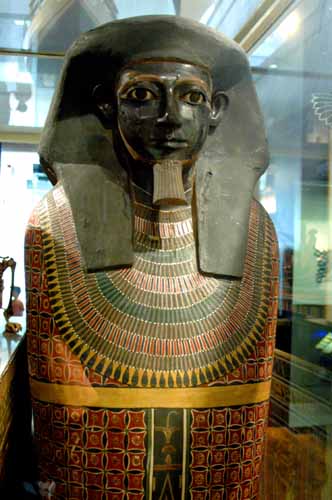

Left - Body coffin of Khnum-Nakht.
Wooden coffin held the body of the Negroid brother. The eyes of
limestone and obsidian are inserted in a bronze rim.
Right - body coffin of Nekht-Ankh.
Coffin has a face which is painted black, although it held the remains
of the non-Negroid brother.
|
Unwrapping
the 'Two Brothers'
 Both
Professor Flinders Petrie and Dr. Margaret Murray, the first Egyptologist
at the Manchester Museum, were convinced that only by continued
study of the objects, which included the mummies themselves, would
the efforts of archaeologists be enhanced. So in 1908, in a large
lecture theatre in Manchester University before a capacity audience,
Dr. Margaret Murray unwrapped the mummies of the 'Two Brothers'.
This was an important development in scientific investigation, for
it involved a multi-disciplinary team. These specialists - in the
fields of anatomy, chemistry and textiles - subsequently carried
out a full-scale investigation of the mummies. Both
Professor Flinders Petrie and Dr. Margaret Murray, the first Egyptologist
at the Manchester Museum, were convinced that only by continued
study of the objects, which included the mummies themselves, would
the efforts of archaeologists be enhanced. So in 1908, in a large
lecture theatre in Manchester University before a capacity audience,
Dr. Margaret Murray unwrapped the mummies of the 'Two Brothers'.
This was an important development in scientific investigation, for
it involved a multi-disciplinary team. These specialists - in the
fields of anatomy, chemistry and textiles - subsequently carried
out a full-scale investigation of the mummies.
There is comparatively little evidence of mummification from the
Middle Kingdom (c.1900 BC) and the bodies that have been examined
show that there was generally less painstaking preparation than
in the Old Kingdom. The internal organs were removed, but less attention
was given to the preservation of the body. Usually a thin cost of
resin was applied to the skin surface, and this left the drying
out of the body incomplete, so that decomposition soon set in. Although
great care was often lavished on the outward appearance of the mummies,
inside there is usually only a jumble of bones with little or no
evidence of soft tissue.
The mummies of the 'Two Brothers' are particularly interesting because
the difference in their condition is very striking. At the tine
of unwrapping, the mummy of Khnum-Nakht was absolutely dry, whereas
the remains of Nekht-Ankh were quite moist and most of the bandages
were wet.
Khnum-Nakht
The mummy of Khnum-Nakht is a good example of the poor standard
of preservation achieved in the Middle Kingdom. There was very little
remaining skin tissue and most of the remnants resolved into a fine
powder at the unwrapping. Also, no special care had been taken to
preserve his nails.
 At
the original investigation Khnum-Nakht was alleged to have a deformity
of the left foot, with skin and tissue thickening indicating a clubfoot
(talipes varus). Later radiological studies have not revealed any
evidence of arthritis or secondary bone change in the foot which
might have been anticipated in a long-standing congenital deformity.
The present study supports the theory that the findings are due
to excessively tight bandaging after death rather than to a clubfoot. At
the original investigation Khnum-Nakht was alleged to have a deformity
of the left foot, with skin and tissue thickening indicating a clubfoot
(talipes varus). Later radiological studies have not revealed any
evidence of arthritis or secondary bone change in the foot which
might have been anticipated in a long-standing congenital deformity.
The present study supports the theory that the findings are due
to excessively tight bandaging after death rather than to a clubfoot.
Khnum-Nakht's spine shows evidence of long-standing arthritis with
abnormal curvature (scoliosis) in the thoracic region. Inspection
of the teeth has revealed an extremely rare developmental abnormality
- double gemination (fusion of the teeth); the two central teeth
are abnormally large and the left one has two roots.
Skeleton of Khnum-Nakht
shows he probably reached early middle-age and that the skull is
negroid. There is almost a complete lack of similarity between
this skeleton and his bother's. His teeth have a double gemination
(fusion of the teeth), the two central teeth are abnormally large
and the left one has two roots.
Nekht-Ankh
The mummy of Nekht-Ankh was better preserved, although the body
had fallen to pieces before unwrapping, the bones were intact and
in position. Even some hair remained, and the embalmers had wrapped
the nails of the fingers and toes with thread to prevent their loss
during the process of mummification. The appearance presented by
this skeleton is suggestive of its being a eunuch, aged about sixty
at time of death. Only Nekht-Ankh had a set of canopic jars and
only two jars in the set had contents. These were identified as
the liver with the gall bladder attached, and lung tissue to which
adhered part of the wall of the heart. Examination revealed that
Nekht-Ankh had suffered from pleurisy, and also from sand pneumoconiosis
which may have been responsible for his death.
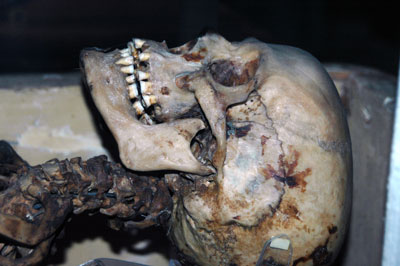 The
report into the anatomical finding begins with the observation that
there was a "remarkable racial difference in the features presented
by each. These differences are so pronounced that it is almost impossible
to convince oneself that they belong to the same race, far less
to the same family. The appearance presented by the skeleton of
Nekht-Ankh is suggestive of its being a eunuch. On first inspection
of the bones at this skeleton the writer was much struck with their
slimness, delicate moulding, and the faintness of the muscular impressions;
indeed, their female character proved to be so pronounced that at
first it was difficult to be sure that the skeleton was really that
of a male. The pelvis was reunited and proved to have all the characteristics
of a male". The
report into the anatomical finding begins with the observation that
there was a "remarkable racial difference in the features presented
by each. These differences are so pronounced that it is almost impossible
to convince oneself that they belong to the same race, far less
to the same family. The appearance presented by the skeleton of
Nekht-Ankh is suggestive of its being a eunuch. On first inspection
of the bones at this skeleton the writer was much struck with their
slimness, delicate moulding, and the faintness of the muscular impressions;
indeed, their female character proved to be so pronounced that at
first it was difficult to be sure that the skeleton was really that
of a male. The pelvis was reunited and proved to have all the characteristics
of a male".
When the two skulls were re-examined in the 1970s, with the help
numerous radiological photographs it was found that there was almost
a total anatomical difference between the features of the two.
The inscriptions on the coffins states that Khnum-Nakht was a 'Great
Waab-priest' of the local god Khnum and both his father and grandfather
bore the title of local mayor - although nether is named. The inscriptions
referring to Nekht-Ankh are rather different. He is referred as
the son of an unnamed local major but his paternal grandfather is
not mentioned. However, the men were sons of the same woman. Aa-Khnumu,
who was an heiress of landed property?
This slight variation in the inscriptions, taken in conjunction
with the men's marked anatomical differences, may indicate that
their mother had two husbands, and that the father of Khnum-Nakht
possessed Nubian ancestry. During much of Egypt's history, there
was a certain mingling of the peoples of Nubia with those of Egypt
at all levels of society. However, it is accepted nowadays that
a child may well inherit a marked similarity to one of his parents
while having no resemblance at all to the other. This could well
be the case with the two brothers, and one had the usual appearance
of an Egyptian while the other had inherited the characteristic
Nubian features.
Another possibility, and equally likely explanation of this difference
in appearance, is that Nekht-Ankh was adopted into the family at
a very early age, and having been a member of it for so many years,
had become accepted as the son of Aa-Khnumu. Future DNA studies
on samples of tissues or bone taken from these bodies may provide
an answer to the question of their relationship. Professor Rosalie
David (OBE, FRSA, Professor of Biomedical Egyptology at the University
of Manchester) confirmed in Nov-2004 that work is being pursued
on the Two Brothers but no DNA studies have yet been undertaken.
|
- Translation and
Transliteration
- Body Coffins
-
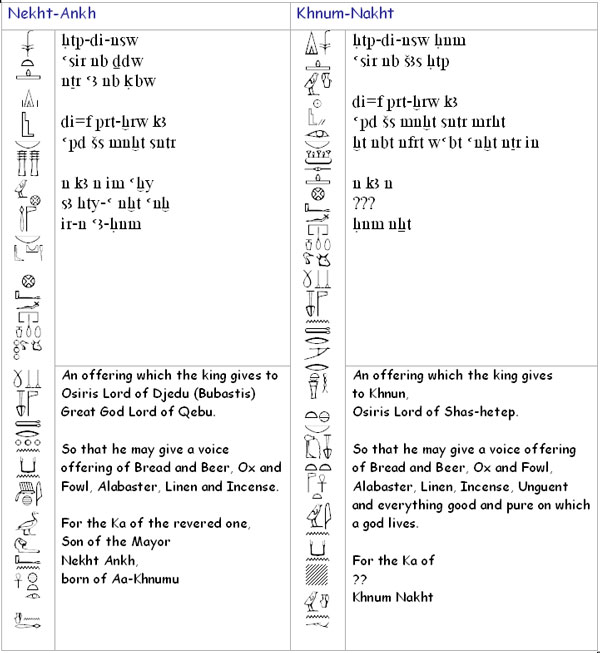
- Note 1 - Hieroglyph
are presented vertically and centrally on the
front of each coffin
- Note 2 - Khnum
was worshiped as the Ba of Osiris at Shas-Hetep
(close to the modern day Asyut)
|
-
- Canopic Chest,
Nekht-Ankh
-
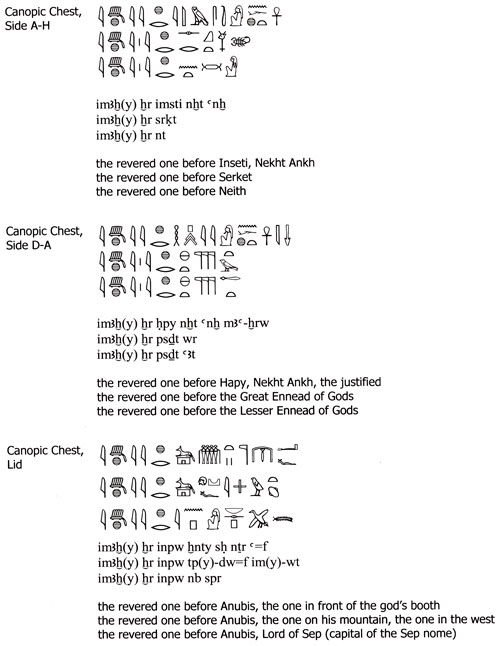
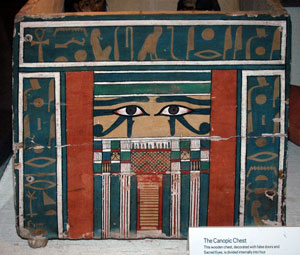

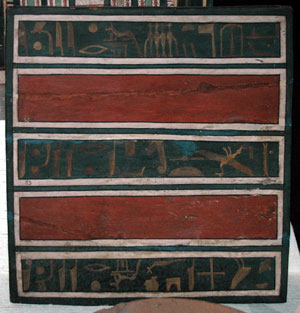
|
-
- Canopic Jars, Nekht-Ankh
 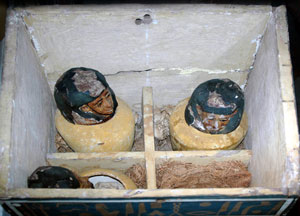
|
Notes
Canopic jars are
protected by the four sons of Horus, said to be
the children
and also the 'souls' of Horus. They are also called
the 'friends of the king' and assist the deceased
monarch in ascending into the sky. Their afterlife
mythology led to important roles in the
funerary assemblage,
particularly in association
with canopic
jars.
Each deity was
guarded by one of the funerary goddesses,
though there was some variation in this linkage.
The group may have been based on the symbolic
completeness of the number four alone, but they
are
often given geographic associations
and hence
became a kind of regional group.
The four gods were the:
1.
human-headed Imseti
who guarded liver (guarded
by Isis)
2.
baboon-headed Hapy who guarded
lungs (protected by Nephthys)
3.
jackal-headed
Duamutef who guarded stomach (often protected
by Neith)
4.
falcon-headed
Qebesenuef,
guardian of intestines (often protected
by Serket)
The four gods were sometimes depicted
on the sides of the canopic chest and had specific
symbolic orientations, with
1.
Imsety
aligned with the south
2.
Hapy with the north
3.
Duamutef with the east
4.
Qebesenuef with the
west
They were also depicted on the long
sides of coffins and sarcophagi with:
1.
Hapy and Qebesenuef
being placed on the west side
2.
Imsety and Duamutef
were placed on the east
Before the 18th Dynasty canopic
jars were given human headed stoppers and from the 18th
Dynasty they were given characteristic representation.
|
Excavation
by Flinders Petrie
Petrie, with the
British School of Archaeology, was excavating in
Egypt in the Giza and Asyut to Sohag region. At
the very end of 1906 they surveyed the area around
the village of Rifeh and finally completed their
activities on 02-April-1907.
The rock-tombs
of Rifeh extend for a few hundred yards at about
a third of the whole height of the cliffs. Those
furthest north were occupied by Coptic burials.
The cemetery of Rifeh is not absolutely dated by
kings' names, except in the 18th and 19th dynasties.
But by the style of its contents it largely belongs
to the 12th dynasty and earlier.
  Left - map of middle Egypt
Right - map of the area from
Asyut to the south
Left - map of middle Egypt
Right - map of the area from
Asyut to the south
|
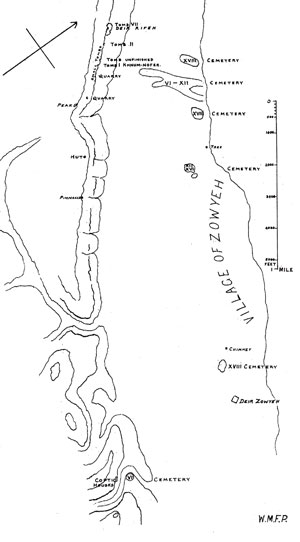 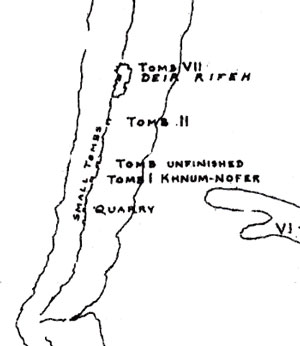 Left
- map of the excavation area Left
- map of the excavation area
Right - map of the
tombs showing the location of Tomb II (the Brothers)
|
|

Tomb No.1, of Khnum-Nofer
Engraved inscription
are on the north wall; on the west are the colossal
figures of the man and his son, also a false door
painted and traces of a scene of the deceased seated
with inscription above it. On the south are traces
of ships, and short phrases. The west side of the
chamber is 389" by 458". The south-east corner is
entirely cut away, owing to Roman quarrying. Also
the whole floor has been lowered from about three
to ten feet by quarrying.
|
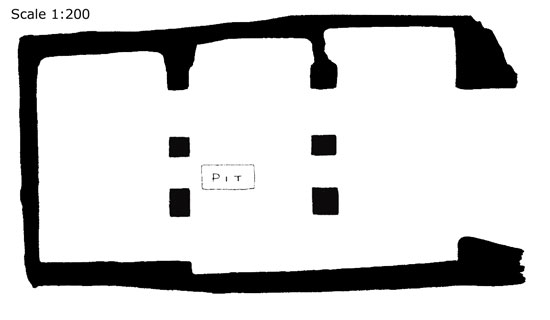 Unfinished Tomb
Further south
is a larger and unfinished tomb. It consists of
a single hall, supported by six pillars, and with
a pit in the middle. The original design was the
pit central and four pillars around it - but it
was enlarged by cutting further into the north side.
Two additional pillars are unfinished, with large
masses of flinty limestone left projecting un-worked.
It's form shows that it was a tomb, and not merely
a quarry.
The hall of this
tomb would have required the excavation of some
thousands of tonnes of rock been removed. The dimensions
are, west of pillars 320", pillar 50", between pillars
300", pillar 65", in front of pillars 293", total
E-W is 1028". Across, north of pillars 66" pillar
60", between 114", pillar 51", between 78", pillar
67", south of pillars 130", total N-S 586".
Unfinished Tomb
Further south
is a larger and unfinished tomb. It consists of
a single hall, supported by six pillars, and with
a pit in the middle. The original design was the
pit central and four pillars around it - but it
was enlarged by cutting further into the north side.
Two additional pillars are unfinished, with large
masses of flinty limestone left projecting un-worked.
It's form shows that it was a tomb, and not merely
a quarry.
The hall of this
tomb would have required the excavation of some
thousands of tonnes of rock been removed. The dimensions
are, west of pillars 320", pillar 50", between pillars
300", pillar 65", in front of pillars 293", total
E-W is 1028". Across, north of pillars 66" pillar
60", between 114", pillar 51", between 78", pillar
67", south of pillars 130", total N-S 586".
|

Tomb No.2, of Khnum-Aa
containing the burials of Khnum-Nakht and Nekht-Ankh
The most important
tomb is a large un-sculptured tomb of three chambers,
with three burial pits. It's style indicates the
12th dynasty, but the only written information is
an ink-written inscription of a re-use during Rameses
III's reign (20th Dynasty).
The courtyard is
215" by 400"; the passage 101" by 171"; the hall
292" x 283" x 474" x 470". The back chamber
204" x 203" x 208" x 210", the recess 46" x 62";
the side chamber 130" x 103" x 102", the recess
39" wide.
In this area a
number of small tombs were found, plundered in antiquity.
The tomb of Nekht-Ankh, son of Aa-Khnumu, was the
found un-plundered. A descending slope led to a
small chamber barely large enough to hold the funeral
furniture, 80" by 70" at the south-east back
and only 50" in front. The heads of the coffins
were toward the opening of the tomb. The finest
coffin, Nekht-Ankh, was that next to the canopic
box. It contained, lying on its side, the finely
decorated body coffin of ha-prince Nekht-Ankh.
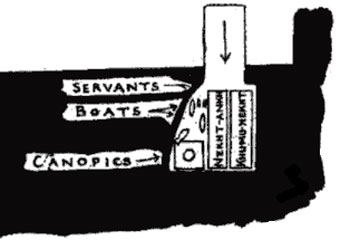 The
second coffin and body coffin are inferior, and
are for Khnum-Nakht. The
second coffin and body coffin are inferior, and
are for Khnum-Nakht.
The canopic box
was in the corner of the tomb; each side is similarly
decorated. Inside it is divided to half-way up by
cross boards of wood. Each compartment has a soft
packing of fibre placed in it; and on that is a
pottery canopic jar, painted yellow and inscribed.
Each jar has a carved wooden head, all human, stuccoed
and painted.
Upon the box stood
a pan containing stalks and leaves. In front of
it was a jar with similar stalks and leaves. Before
that stood the two boats; the one for sailing up
the Nile, with the men gathered to pull the rope
raising the yard; the other with the mast laid down
and the sweeps out for rowing down the Nile. With
these stood the two female figures of servants carrying
offerings. The whole of the funeral furniture and
coffins are of the highest quality of this period.
|
12th Dynasty tomb equipment
At the beginning of
the 12th Dynasty the elite/royal cemetery moved
from Thebes to Lisht, which has a different kind
of topography. The area didn't have adjacent cliffs
and mastaba type tombs replaced rock tombs. However,
in the area that the brothers were buried, the local
tradition of rock cut tombs continued in the Middle
Kingdom and it into the New Kingdom (Petrie excavated
tombs dating until the 18th Dynasty at Rifeh). Rock-cut
tombs are generally well preserved but are not typical
of the period.
Written text has always been an important part of
Egyptian burials. Canopic jars underwent changes
in their form during the Middle Kingdom. At the
beginning of the period jars with human heads are
found. The jar stoppers are made of wood and the
body of the jar is often made of clay; high quality
examples may be made from limestone or calcite.
A set of canopic jars (within a chest) is normal
within an elite burial, but less common in the provinces.
Many refinements found in the elite cemeteries were
later introduced in the provincial cemeteries. For
example, coffins with a palace facade were found
at a Lisht early in the period and only appeared
later in the Middle Kingdom in provincial cemeteries
- the same can be said of wooden models of solar
boats.
The reign of Senusret III (ruled 1870-1831 BC) introduced
change into many areas of court life in Ancient
Egypt. It seems that major reorganisation of the
administration happened during this time, new titles
appeared in the administration and some provincial
cemeteries cease to exist, and other cemeteries
continued but on a much smaller scale. The body
of the dead person was now no longer placed on its
left side, but laid on its back with its hands by
its side. The disappearance of Coffin Texts and
Wooden models is noticeable. Only a limited set
of objects were specifically manufactured for burial,
for example heart scarabs and mummiform figures.
During the 13th Dynasty the palace facade disappeared
from coffins. In Upper Egypt the number of columns
was increased, some coffins at eight or nine columns
on each long sight. In lower Egypt coffins with
four columns of text on the alongside and religious
texts in the space between are found.
It is clear that significant change to burial customs
did not happen between Dynasties which makes it
very difficult to date a burial, for example, the
12th or 13th Dynasty. It is even more difficult
to determine where, within a Dynasty, where a burial
can be placed.
From the quality
of Nekht-Ankh's burial, the canopic jars, model
boats, style of coffin and columns of text and the
similar style of Khnum-Nakht's coffin, we could
propose that they lived within the early part of
the 12th Dynasty, possible before Senusret III's
reign.
|
- Khnum
-
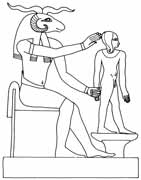 Khnum
is the ram-god creator of life on the potter's
wheel, he was called 'high of plumes, sharp
of horns', had primarily an association with
the Nile cataract. He controls the annual inundation
of the river from the caverns of Hapy, the god
personifying the flood itself. Khnum
is the ram-god creator of life on the potter's
wheel, he was called 'high of plumes, sharp
of horns', had primarily an association with
the Nile cataract. He controls the annual inundation
of the river from the caverns of Hapy, the god
personifying the flood itself.
-
- His importance
at Elephantine can be traced back to the early
dynastic period although the archaeological
evidence is predominantly from the New Kingdom
and Graeco-Roman period. Rams sacred to Khnum
have been discovered on Elephantine Island,
mummified, adorned with gilded head-pieces and
buried in stone sarcophagi. A stela was carved
on a dominant rock on Seheil Island overlooking
the first cataract which emphasises the antiquity
of Khnum's cult at Elephantine. The inscription
itself is a Ptolemaic copy (or forgery) of an
original document dating to the reign of King
Djoser (3rd Dynasty). There has been a seven
year famine which Djoser is trying to halt.
Khnum relents from preventing the Nile flood,
on being assured of his temple's renovation
and regular income of Nubian wealth, and Egypt
prospers again.
 In
his supervision over the cataract region he is assisted
by the goddesses Satis and Anket. He was also regarded
in this aspect as lord of the cataract as the 'Ba'
(soul) of the sun-god, hence his name becomes Khnum-Re.
This strong connection with the river lies behind
one of his titles 'lord of the crocodiles', intensified
by the presence of the goddess Neith, mother of
the crocodile-god Sobek, as the most important guest
deity in his temple at Esna. In
his supervision over the cataract region he is assisted
by the goddesses Satis and Anket. He was also regarded
in this aspect as lord of the cataract as the 'Ba'
(soul) of the sun-god, hence his name becomes Khnum-Re.
This strong connection with the river lies behind
one of his titles 'lord of the crocodiles', intensified
by the presence of the goddess Neith, mother of
the crocodile-god Sobek, as the most important guest
deity in his temple at Esna.
His other major
role is probably derived from the procreative powers
of the ram and the life supporting river which make
him eminently suitable as a creator-god. The iconography
represents Khnum seated before a potter's wheel
on which stands the being which he has moulded into
existence. The god normally performs this task at
the behest of another deity, e.g. in the theogamies
on Theban temple walls or in the story of the Two
Brothers where Khnum is instructed to fashion a
wife for Bata. It seems that Khnum breathes in the
life force to the created being, as mentioned in
the Westcar Papyrus where after the divine birth
of the first three kings of the 5th dynasty Khnum
is said to put 'health' into each of their bodies.
It is the aspect
of Khnum as 'potter' that is especially venerated
in his main cult centre north of the first cataract
at Esna. This temple which survives only in the
form of one hypostyle hall surrounded by the modem
conurbation is also sacred to Khnum in a manifestation
strongly allied to the air-god Shu as war-champion
of the sun-god. Important hymns provide a manifesto
of the priests' belief in the supremacy of their
god of the potter's wheel responsible for fashioning
gods, mankind, cattle, birds and fish. The different
speeches of the human race are also his gift. His
consort at Esna (Neith having a totally independent
role in this temple) is a minor lioness-goddess
called Menhyt.
|
|
|


 Both
Professor Flinders Petrie and Dr. Margaret Murray, the first Egyptologist
at the Manchester Museum, were convinced that only by continued
study of the objects, which included the mummies themselves, would
the efforts of archaeologists be enhanced. So in 1908, in a large
lecture theatre in Manchester University before a capacity audience,
Dr. Margaret Murray unwrapped the mummies of the 'Two Brothers'.
This was an important development in scientific investigation, for
it involved a multi-disciplinary team. These specialists - in the
fields of anatomy, chemistry and textiles - subsequently carried
out a full-scale investigation of the mummies.
Both
Professor Flinders Petrie and Dr. Margaret Murray, the first Egyptologist
at the Manchester Museum, were convinced that only by continued
study of the objects, which included the mummies themselves, would
the efforts of archaeologists be enhanced. So in 1908, in a large
lecture theatre in Manchester University before a capacity audience,
Dr. Margaret Murray unwrapped the mummies of the 'Two Brothers'.
This was an important development in scientific investigation, for
it involved a multi-disciplinary team. These specialists - in the
fields of anatomy, chemistry and textiles - subsequently carried
out a full-scale investigation of the mummies. At
the original investigation Khnum-Nakht was alleged to have a deformity
of the left foot, with skin and tissue thickening indicating a clubfoot
(talipes varus). Later radiological studies have not revealed any
evidence of arthritis or secondary bone change in the foot which
might have been anticipated in a long-standing congenital deformity.
The present study supports the theory that the findings are due
to excessively tight bandaging after death rather than to a clubfoot.
At
the original investigation Khnum-Nakht was alleged to have a deformity
of the left foot, with skin and tissue thickening indicating a clubfoot
(talipes varus). Later radiological studies have not revealed any
evidence of arthritis or secondary bone change in the foot which
might have been anticipated in a long-standing congenital deformity.
The present study supports the theory that the findings are due
to excessively tight bandaging after death rather than to a clubfoot.
 The
report into the anatomical finding begins with the observation that
there was a "remarkable racial difference in the features presented
by each. These differences are so pronounced that it is almost impossible
to convince oneself that they belong to the same race, far less
to the same family. The appearance presented by the skeleton of
Nekht-Ankh is suggestive of its being a eunuch. On first inspection
of the bones at this skeleton the writer was much struck with their
slimness, delicate moulding, and the faintness of the muscular impressions;
indeed, their female character proved to be so pronounced that at
first it was difficult to be sure that the skeleton was really that
of a male. The pelvis was reunited and proved to have all the characteristics
of a male".
The
report into the anatomical finding begins with the observation that
there was a "remarkable racial difference in the features presented
by each. These differences are so pronounced that it is almost impossible
to convince oneself that they belong to the same race, far less
to the same family. The appearance presented by the skeleton of
Nekht-Ankh is suggestive of its being a eunuch. On first inspection
of the bones at this skeleton the writer was much struck with their
slimness, delicate moulding, and the faintness of the muscular impressions;
indeed, their female character proved to be so pronounced that at
first it was difficult to be sure that the skeleton was really that
of a male. The pelvis was reunited and proved to have all the characteristics
of a male".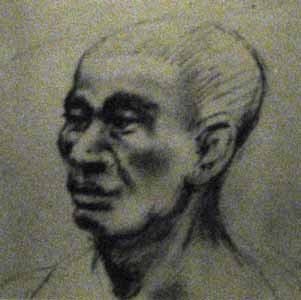


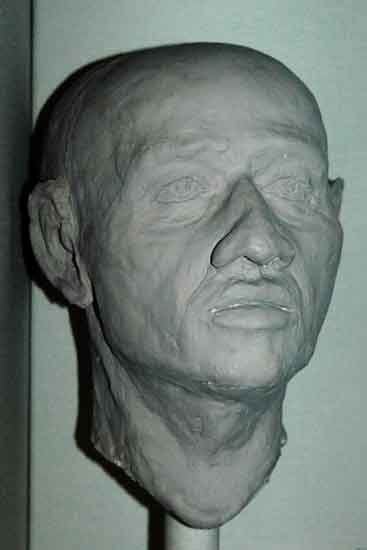










 Left
- map of the excavation area
Left
- map of the excavation area


 The
second coffin and body coffin are inferior, and
are for Khnum-Nakht.
The
second coffin and body coffin are inferior, and
are for Khnum-Nakht.  Khnum
is the ram-god creator of life on the potter's
wheel, he was called 'high of plumes, sharp
of horns', had primarily an association with
the Nile cataract. He controls the annual inundation
of the river from the caverns of Hapy, the god
personifying the flood itself.
Khnum
is the ram-god creator of life on the potter's
wheel, he was called 'high of plumes, sharp
of horns', had primarily an association with
the Nile cataract. He controls the annual inundation
of the river from the caverns of Hapy, the god
personifying the flood itself.